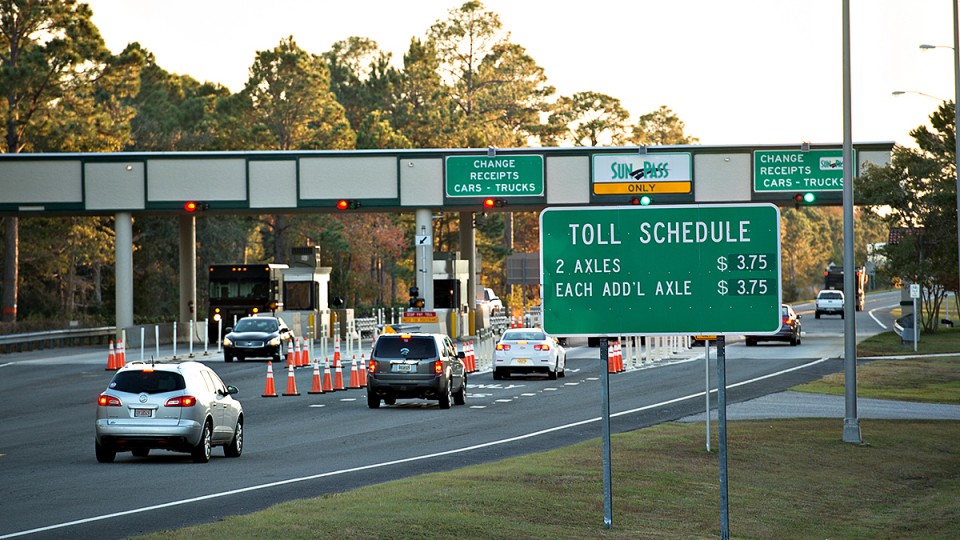Is Garcon Point bridge toll worth taking to court?
- September 17, 2015
- / Louis Cooper
- / community-dashboard

Whether the toll on the Garcon Point Bridge will go up to $5 depends on the bondholders' appetite for taking the state to court. Photo credit: Michael Spooneybarger
Whether the fight to increase the toll on the Garcon Point Bridge is over will depend on whether the bondholders have the stomach – and the cash – to take the matter to court.
Investors who hold the $95 million in bonds that funded construction of the bridge were sent notice
Sept. 8 from the Bank of New York Mellon telling them that Florida Department of Transportation has refused to institute a requested increase in tolls on the span and the only option is to take the state to court.
Opening in May 1999, the Garcon Point Bridge has never met its financial obligations. While the bridge was authorized by the Legislature, it was funded with bonds purchased by private investors who believed they were guaranteed a set return.
The bridge was meant to improve the quality of life in Santa Rosa County by making the commute between north and south county easier as the population boomed. While Santa Rosa has seen its population boom between 2000 and 2015 – from about 118,000 to about 167,000 – that growth has not been enough to make the bridge solvent.
Population growth is one of the 16 metrics measured in the Studer Community Institute Dashboard. Those 16 metrics were developed with the University of West Florida to measure the economic, educational and social well-being and quality of life in the Pensacola metro area.
The dashboard also tracks per capita income. A toll increase, potentially impacting many people who use the bridge to get to and from work or school, could put added burden on Santa Rosa residents, where per capita income is $37,739, which is below the state average of $42,645.
The bank – acting as trustee of the bonds – asked the state to increase the bridge’s one-way cash toll from $3.75 to $5 to help recover the defaulted debt.
“The trustee will file suit against FDOT provided it receives direction and satisfactory indemnity against the costs, expenses and liabilities, including attorneys' fees and expenses, that may be incurred in connection therewith from bondholders,” the letter read.
“However, absent such direction and indemnity, the trustee is unwilling to file suit against FDOT at the present time given, among other things, the costs of such litigation and the potential damage to bondholders.”
The letter provided an address for bondholders to offer feedback to the bank, but did not include a deadline. The letter also included contact information for the FDOT if bondholders wish to contact the department directly.
Kevin Heine, the representative of the Bank of New York Mellon who provided the notice to the Studer Community Institute, declined to say whether the bank is actively polling bondholders or if there is a deadline by which the trustee would decide whether to file suit.
In attempts to maximize revenues, the toll steadily has increased since it opened in 1999. To begin with, it was $2. In 2002, it increased to $2.50. It went to $3 in 2004, and to $3.50 in 2007. In 2011, it jumped to the current $3.75.
State Rep. Doug Broxson, R-Gulf Breeze, has been working to avoid the increase since New York Mellon first sent a letter on Nov. 6, 2014, requesting the toll be increased.
At issue, according to Broxson, are the bond documents that govern how the bridge is to be run. They established the Santa Rosa Bay Bridge Authority to set tolls. That body is supposed to be made up of three members appointed by the Santa Rosa County Commission and three members appointed by the governor.
However, that board has been empty since December 2014 when the last member resigned.
In March, the New York Mellon requested that the FDOT administratively increase the toll, but DOT refused.
“The state’s position is very clear,” Broxson said. “They created this document that says how they are going to operate, but they don’t have a partner who allows then to implement it. We’re not going to be a fallback position.”
 CivicCon launches with a look at good growth in cities
CivicCon launches with a look at good growth in cities
 Building stronger brains one baby, one parent at a time
Building stronger brains one baby, one parent at a time
 SCI debuts commercial on Early Learning City
SCI debuts commercial on Early Learning City
 Entrecon: World class speakers and an opportunity to sharpen skills
Entrecon: World class speakers and an opportunity to sharpen skills
 PYP Quality of Life survey 2017
PYP Quality of Life survey 2017
 EntreCon Pensacola 2016: A look back
EntreCon Pensacola 2016: A look back
 Leadership tip: getting better employee takeaways
Leadership tip: getting better employee takeaways
 Leadership tip: be interested instead of interesting
Leadership tip: be interested instead of interesting
 Leadership tip: delivering difficult messages
Leadership tip: delivering difficult messages
 Brain Bags boost Arc, Early Childhood Court programs
Brain Bags boost Arc, Early Childhood Court programs